The One Thing Holding You Back From Reaching Your Full Potential
What is Mobility?
Definition: the ability to move or be moved freely and easily.
Mobility is critical to increasing strength and preventing injuries.
When people first get into exercising, they normally focus primarily on how many push-ups and pull-ups they can do. Their plan for increasing strength centres around the number of reps they perform. Advanced fitness enthusiasts, on the other hand, understand that improving mobility is the key to developing strength and balance, AND preventing injuries.
Mobility is not the same as flexibility. Flexibility is a component of mobility, but it is not the only part of it.
A flexible person may or may not have the core strength, balance, or coordination to perform the same functional movements as a person with great mobility
Mobility is a movement-based integrated full-body approach that addresses all the elements that limit movement and performance including short and tight muscles, soft tissue restriction, joint restriction, motor control problems, joint range of motion dysfunction, and neural dynamic issues. In short, mobilization is a tool to address movement and performance problems.
Mobility should be a proactive approach, not a reactive one. In other words, don’t wait until problems arise before you address them.
How Do You Improve Mobility?
The first method is passive stretching – which is a technique in which you are relaxed and make no contribution to the range of motion. Instead, an external force is created by an outside agent, either manually or mechanically.

Photos by: https://www.instagram.com/tomjoyphoto
The second is to bring your joint through a full range of motion under varying degrees of tension. There doesn’t need to be a lot of tension, but there must be some.
You don’t need to spend hours working on your mobility, the trick is to incorporate little bits multiple times a day over a long period of time. Like with any change in lifestyle – consistency is key.
The Most Common Mobility Issues
There are hundreds of issues that can crop up when it comes to mobility but these four are the most common.
Tight shoulders and overhead mobility – the inability to raise your extended arms directly above your head without your ribcage flaring or lower back arching too much.
Tight Ankles/Calves – This can have a negative effect on squat depth and increase the chance of injury when performing high-intensity workouts.
Squat Depth – sitting down in chairs all day means many of us have lost the ability to sit in a deep squat without our heels lifting.
Hip Flexors – This can lead to your pelvis tilting which can put extra stress on your lower back, when I get tight hip flexors I wake up with a stiff back in the mornings.
How Often Should I Do Mobility Work?
It’s best to do mobility work every day, ideally more than once. Especially if you are sitting at a desk all day!
I work on my mobility at three different times per day. I do 10 minutes first thing in the morning, 15 minutes as part of my warm-up for working out and 10-20 minutes right before bed.
Initially, you will wonder why you are doing it, but after consistent practice, you really will see and feel the difference. You will wonder how on earth you managed to function with a restricted range of motion!
As always consistency is key.